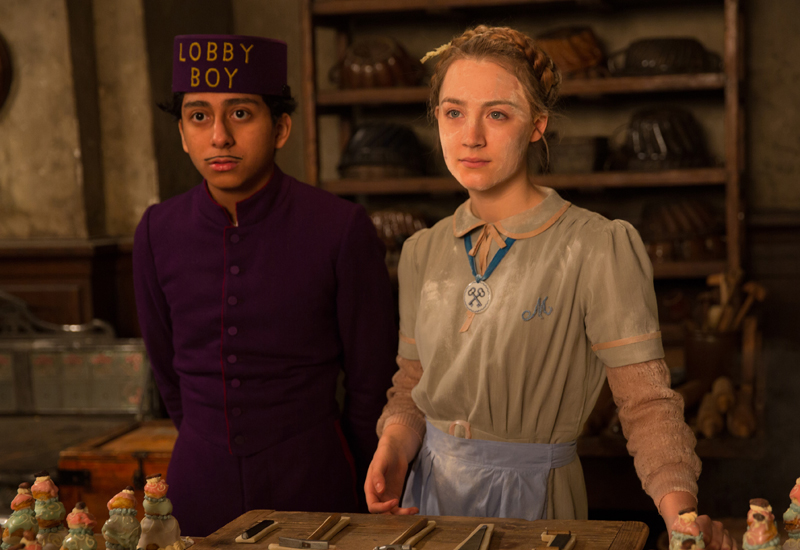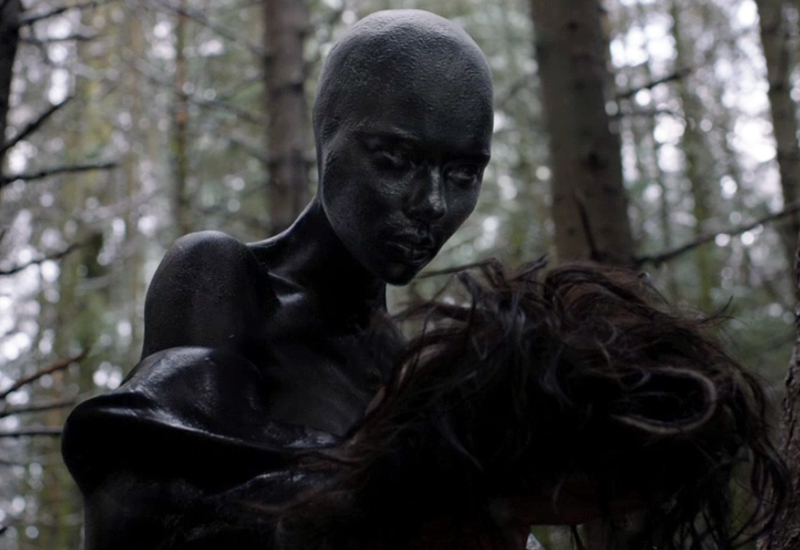We celebrate the end of the year the only way we know how: through lists, essays, and mixes. Join us as we explore the music and films that helped define the year. More from this series
10. Guardians of the Galaxy
Dir. James Gunn
[Marvel Studios]

James Gunn’s Guardians of the Galaxy opened with a young boy seated in a dark hospital corridor, his eyes closed, listening to 10cc’s “I’m Not in Love” on a portable cassette tape player. He sat, lost in temporary ecstasy for a few seconds, before being shaken out of his stupor to the reality of his mother’s imminent death from cancer. This brief moment essentially gave us the whole film in a nutshell, as Guardians of the Galaxy was nothing if not an escapist science fiction fantasy that, despite its humor and glossy veneer, was at its core a story of insecurity, loss, and death. As we watched Peter Quill (Chris Pratt) rocket off into the cosmos, along with his merry band of losers (in the most literal sense of the word), the film enacted its own promise: a journey to the stars to forget the real world for a couple of hours. And despite the mega-effects and blockbuster action sequences, Guardians was a science fiction film where the most pivotal piece of technology was a cheap Walkman. So with one foot in the stars and one foot firmly on painful planet Earth, Guardians of the Galaxy invited us to put on headphones, close our eyes, and let the fantasy temporarily take us away.
09. Butter on the Latch / Thou Wast Mild and Lovely
Dir. Josephine Decker
[Cinelicious Pics]

Perhaps a familiar face to regular TMT film readers, arts-scene polymath Josephine Decker bit into 2014 cinema with two brilliant directorial efforts, Butter on the Latch and Thou Wast Mild and Lovely. Uniting the two films were shaky handheld visuals that remember their subjects like fever dreams. The fluttering cinematography transcended the point-and-shoot amateurism of a YouTube upload and transformed it into something lyrical and haunting, with precious details either out of focus or out of frame, creating menace, ambiguity, and, in a landscape where everyone has a camera in their pocket, authenticity. As we followed the stories of a hired farm-hand’s nauseous romance (Thou Wast Mild and Lovely) and two friends’ somehow simultaneously tense and idyllic stay at a folk camp in California (Butter on the Latch), we experienced in-depth character studies while delving minimally into anything plotty. The films managed to feel literary without being wordy, casual without being blasé or boring. Decker’s voice uniquely combined gentleness with a dark undercurrent, making compelling anything on which she trained her camera.
08. The LEGO Movie
Dir. Phil Lord & Christopher Miller
[Warner Bros.]

If we critics are honest, the greatness of The LEGO Movie might be overstated in relation to how low our expectations likely were for it. A film based on a bunch of plastic building blocks sure seemed like a dead-on-arrival proposition. Yet writer/directors Phil Lord and Christopher Miller wound up with a smart, witty, action-packed movie that spoke directly to the creative spirit of their source material and that not even a wonky, hoky live-action sequence could ruin. All of those positive qualities became even richer thanks to some eye-popping computer animation and pitch-perfect voice acting work by Chris Pratt, Will Ferrell, Elizabeth Banks, Will Arnett, and an especially ridiculous Liam Neeson. Apparently a sequel is in the works, which has me instantly suspicious. But, again, that might work to Lord and Miller’s advantage, as they could wind up sucker-punching us with excellence once more.
07. Why Don’t You Play in Hell?
Dir. Sion Sono
[Drafthouse Films]

The capacity to communicate a joy that’s both tangible and exhilarating without careening headlong into some kind of Hallmark Card/Lifetime Network schmaltz freakshow has never been in over-abundance, yet it’s something that Sion Sono pulls off pretty damn consistently. Whereas our culture’s preoccupation with tacky displays of saccharine sentimentality is nothing new, it sure seems that it’s getting a lot easier to mass produce emotionally-manipulative content for profit than ever before. A natural effect of which is a generally healthy skepticism toward anything that radiates pure, undiluted happiness, and it’s no secret we’ve got plenty of curmudgeonly skepticism to go around here at TMT. However, this year saw our favorite ridiculously prolific director making his most unabashedly joyous film to date. Sono’s masterful ode to the spectrum of Japanese cinema was an intense, intensely screwed up, and altogether incredible movie experience. If TMT Film gets amped up about movies that blur the line between auteurism and gleeful trash (which, duh), then Why Don’t You Play in Hell? was something of a coup. Everything about this movie was great, from its loving send-up of yakuza movies to the way it so thoroughly nailed the excitement, fatigue, and full-hearted youthful exuberance of trying to make a movie without much money or decent equipment. We loved every minute of it.
06. A Spell to Ward Off the Darkness
Dir. Ben Rivers & Ben Russell
[Rouge International]

Once again, this decade proves its greatest strengths are in materialist cinema, but in the case of the wondrous A Spell to Ward Off the Darkness, spare and languid quasi-documentary images of water, trees, communes, and black metal were steered toward incantatory rather than descriptive ends. Starring Lichens’ Robert A.A. Lowe, this elliptically moving ode to stasis and movement both social and physical eclipsed the previous work of both co-directors, reinvigorating slow cinema and morphing hipster iconography and neo-New Age referents into something imagistic and powerful. Perhaps the first film to grasp black metal on an aesthetic level, it was a sustained roar into the ether and a triumph that earned its weirdly literalist title.
05. Borgman
Dir. Alex van Warmerdam
[Drafthouse Films]

There’s something faintly nihilistic about wandering. Our idle curiosities, when they arrive, are borne on a sense of security. While one’s longing for and clinging to comfort zones are natural, one’s vague awareness of the world around them can collapse this basic drive. With Borgman, director Alex van Warmerdam showed us a staid, yet logically untethered microcosm of this sort of collapse. While the titular character and his cohorts were an uncanny, cryptic bunch, the family they converge upon wound up being the most confounding. They came off as an extreme, somewhat satirical version of the smugly affluent. The biggest laughs came from the rigid, played-out pathos they feebly inhabited, as the inexplicable events unfolded (cresting with Richard’s relief at having his mysterious “X” tattoo removed). We ambled through this methodical nightmare much like Camiel, faintly stirred but decidedly detached. There was very little shock to this particular cinematic murder spree. In its place was a muted sense of wonder and a strident mistrust of our puzzleout instincts. The true horror of this film was witnessing the deep wilderness of the unknown grow over the quaint accoutrements of human civilization and feeling a surprising sense of relief.
04. Stranger by the Lake
Dir. Alain Guiraudie
[Strand Releasing]

Every shot and every conversation in Stranger by the Lake was about boundaries. Alain Guiraudie’s film was set in one location (a gay cruising spot on the water) that turned out to be a handful of semi-autonomous zones. Each had its own rules and social customs: the parking lot; the rocky slope for platonic friendship; the beach for flirting and ogling; a boundless and undefined green space for sexual release; and the water, a typically fluid locus of serenity, play, and primal fear. Stranger by the Lake’s leisurely tone and gorgeous naturalism underplayed how rigorously Guiraudie defined and then tested these boundaries, as a community of strangers navigated competing urges toward friendship, lust, love, and death. Acts of personal liberty and of societal transgression became dangerously, intensely confused, until the film’s simultaneously thrilling and bewildering final scene called the very nature of agency into question. Stranger by the Lake can be read as a canonical work of queer cinema about social dynamics under the constant threat of fatal disease (the film’s mythical silurus) and police surveillance, but it’s even better as a film about emotional boundaries and the irresistible pull of irrational desires.
03. The Grand Budapest Hotel
Dir. Wes Anderson
[Fox Searchlight]

What’s it gonna take with you people? The “haters,” I mean… I tell you, I’ll bet Busby Berkeley never had to put up with this nonsense (I mean, of course not… no internet). Why, these fine young people went the extra mile to craft for us an extravagant, colorful, fluffy, painstakingly symmetrical piece of entertainment, and yet the brays of the hecklers would nary be silenced! Wes Anderson is “in a rut,” you say? “Endless daddy issues,” is it? “Shallow,” you think? Guess what, palooka: I ain’t listenin’, and neither is Wes Anderson. No matter what you say, he’s gonna keep making these movies, wiping away a single tear with a $100 bill (or color-coordinated handkerchief) every time you talk shit. Taken for what it is (as opposed to framing it with one’s expectations or prejudices), The Grand Budapest Hotel was a fine film, funny and huge and full of glistening wonder, a big show to beat all big shows (sans the dumbing down typically concomitant with such shows). Yeah, it was as emotionally ephemeral as most of Anderson’s films, but those mile-a-minute comic speeches and obsessive details will lodge in your mind’s eye/ear for some time to come, if you let them.
02. Boyhood
Dir. Richard Linklater
[IFC Films]

William Gass put it best: “Childhood is a lie of poetry.” Our memories become like montages: a swift passing of image and sentiment, alight in sepia-tones, and soundtracked appropriately. However, they are notoriously deceptive. Therefore, we’ve supported memories with photographs and recordings and films. We’ve further supplanted those with the unrelenting preservation of curated identities — memories of ourselves distilled to their referents. We long to remember ourselves, even as our memories remain elusive, even as each retelling is slightly different from the last. So we run alongside the lies. We tell ourselves it was otherwise, or could yet be. In the end, as other have already said, we scarcely know ourselves. As 2014 comes to a close, and even my most recent memories begin to dissipate, I remember (I think) the feeling I had as I drove home from seeing Boyhood. I kept silent and fought off tears. No film, in recent memory, has made me feel more vulnerable to myself. The critic in me wants to praise — endlessly — the details. I want to fawn over the innumerable gestures that made it a masterpiece. I want to marvel, with everyone else, at the utter dedication. I want to nod, too quickly, toward its flaws. But the boy in me, whoever he was, has no use for the critic. Somewhere, somehow, in the swirl of experiences I’ve appropriated as my own, I’ve come to touch the heart of the lie. Whatever happened, it’s simply enough to feel its beating.
01. Under The Skin
Dir. Jonathan Glazer
[A24 Films]

What shape are binaries?
In Jonathan Glazer’s Under the Skin — a film that many critics tidily read as a fable about inequality in the construction of and dynamics between men and women — the primary form was symmetry. Two simple, glossy orbs were the first images to appear on screen, moving gently against a background of blankness, their abstractness eventually congealing into an eye. The shapes of elementary school geometry have rarely been so inexplicably menacing.
As an alien creature with a human female’s appearance and a world of social knowledge to master, Scarlett Johansson’s own face often recalled the formally-precise blank space of that opening sequence as she navigated urban Glasgow in a white van, methodically using the language of gender performance as an instrumental device — instead of an identitarian expression — to ask men for directions, determine if they were alone and vulnerable, and lure them, with the promise of sex, to a house whose interiors resembled an obsidian pitcher plant in both form and function.
Glazer filmed Johansson unglamorously, emphasizing her body-as-object instead of the aura surrounding it (men and landscapes, too, had pronounced physicality: at one point, Johansson’s sleeping form was superimposed over a forest — it was not a juxtaposition). The alien protagonist blended into the street scenes of everyday Glasgow and, more importantly, into the film’s stunningly integrated documentary sequences (some of the men who approached her were not actors). The camera turned us into anthropologists, observing — like she did — ordinary men with detached but intense curiosity: the little ways their clothes didn’t fit right, how flattery made them take up more space. We also observed Johansson as she observed herself: when she stood naked in front of a mirror examining her new body with curiosity and concern, we likewise scrutinized the novelty, deciding what it meant. Her real eyes, audiences might have noticed, were not as centered as the orbs of the opening sequence they echoed.
The men she had captured decomposed into raw materials, while Johannson, having learned too much about society to be able to prey on it, fled. A man in the woods politely determined if she were alone and vulnerable, used a reconfigured combination of her own approach of sex and violence, and after discovering the non-human form lurking underneath, decomposed her into raw material. Through fire, instead of liquid. The film ended with a plume of smoke against a sky that was nearly blank with snow, reminding us, as the film’s introduction did, that in the move from flesh to abstraction, the body gets left behind.
Symmetry is beautiful. Under the Skin, while terrifying, was not an exception, even as it refused to use symmetrical human bodies as shortcuts to beauty, preferring to construct its own. Its narrative circularity; Mica Levi’s haunting, repetitive score; the recurring and prolonged use of the screen as alternately white and black blank space; circles and orbs; the decompositions of bodies — these were the most starkly gorgeous filmic aesthetics of 2014.
Symmetry is also a mirror, a Rorschach, a reflection of who is looking. A critic at a popular listicle site argued — with a few lines of text and a series of .gifs — that Under the Skin subverts the male gaze, citing Laura Mulvey’s 1975 concept — which borrows heavily, especially in the castration anxiety area, from Freud — explaining the relationships of power between viewers, camera lenses, and actresses in 1950s cinema. It’s true Glazer did not objectify bodies. Instead, he considered them as objects, not signifiers of something else: a gender, a social dynamic, power. Johansson’s alien was neither shorthand for the idea of patriarchal filmic pleasure nor shorthand for its opposite.
Johansson has recently performed a string of variations on inhumanity, from this year’s Lucy, in which she played a human who masters all knowledge in the universe, to last year’s Her, in which she played an operating system that masters all knowledge in the universe. Under the Skin wasn’t only the best of these performances, but also the only one that positioned the body as a path to knowledge rather than an obstacle to it. Under Glazer’s lens, the metaphysical — whether data, identity, or ideology — was re-embedded into the site from which we experience it daily, and from which media — and its critics — daily wrenches it away.
Glazer’s previous films — Sexy Beast, Birth, and some music videos for a band TMT used to like — were interesting, but we couldn’t have predicted such a profoundly vital statement — or the negation of one — from him this year. Instead of the long-awaited apex of an artistic trajectory, Under the Skin just appeared here unexplained, much like its protagonist. But unlike her, we’re still trying to learn its alien language, and grateful for the opportunity.
We celebrate the end of the year the only way we know how: through lists, essays, and mixes. Join us as we explore the music and films that helped define the year. More from this series
